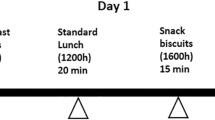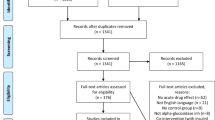Abstract
Background: We have repeatedly reported that American ginseng (AG) with a specific ginsenoside profile significantly decreases postprandial glycemia. Whether this effect is reproducible using AG with a different profile is unknown. We therefore investigated the effect of a different batch of AG on glycemia following a 75 g oral glucose tolerance test (OGTT).
Methods: Using a randomized, single blind design, 12 normal subjects (six males and six females, aged 31±3 y, body mass index (BMI) 28±2 kg/m2) received 6 g AG or placebo 40 min before a 75 g OGTT. The protocol followed the guidelines for the OGTT, with venous blood samples drawn at −40, 0, 15, 30, 45, 60, 90 and 120 min. Ginsenosides in the AG were assessed by established methods for HPLC-UV.
Results: Repeated measures analysis of variance demonstrated that there was no significant effect of the AG on incremental plasma glucose (PG) or insulin (PI) or their areas under the curve Indices of insulin sensitivity (insulin sensitivity index (ISI)) and release (ΔPI30-0/ΔPG30-0) calculated from the OGTT were also unaffected. The AG contained 1.66% total ginsenosides, 0.90% (20S)-protopanaxadiol (PPD) ginsenosides, and 0.75% (20S)-protopanaxatriol (PPT) ginsenosides, with the following key ratios: PPD:PPT of 1.2, Rb1:Rg1 of 8.1, and Rb2:Rc of 0.18.
Conclusion: The present batch of AG was unable to reproduce the postprandial hypoglycemic effects we observed previously. Possible explanations for this discrepancy include marked decrements in total ginsenosides and the key ratios PPD:PPT, Rb1:Rg1, and Rb2:Rc. These data suggest that the ginsenoside profile of AG might play a role in its hypoglycemic effects. The involvement of other components cannot, however, be precluded.
This is a preview of subscription content, access via your institution
Access options
Subscribe to this journal
Receive 12 print issues and online access
$259.00 per year
only $21.58 per issue
Buy this article
- Purchase on Springer Link
- Instant access to full article PDF
Prices may be subject to local taxes which are calculated during checkout

Similar content being viewed by others
References
Angell, M & Kassirer, JP (1998). Alternative Medicine—the risks of untested and unregulated remedies. New Engl. J. Med., 339, 839–841.
Attele, AS, Wu, JA & Yuan, CS (1999). Ginseng pharmacology: multiple constituents and multiple actions. Biochem. Pharmacol., 58, 1685–1693.
Awang, DVC (2000). The neglected ginsenosides of North American ginseng (panax quinquefolius L.). J. Herbs Spices Med. Plants, 7, 103–109.
Chan, TWD, But, PPH, Cheng, SW, Kwok, IMY, Lau, FW & Xu, HX (2000). Differentiation and Authentication of Panax ginseng, Panax quinquefolius, and Ginseng Products by Using HPLC/MS. Analy. Chem., 72, 1281–1287.
Cui, JF (1995). Identification and quantification of ginsenosides in various commercial ginseng preparations. Eur. J. Pharm. Sci., 3, 77–85.
Eisenberg, DM, Davis, RB, Ettner, SL, Appel, S, Wilkey, S, Van Rompay, M & Kessler, RC (1998). Trends in Alternative Medicine use in the United States, 190–1997: Results of a Follow-up National Survey. J.A.M.A., 280, 1569–1575.
Fitzloff, JF, Yat, P, Lu, ZZ, Awang, DVC, Arnason, JT, van Breeman, RB, Hall, T, Blumethal, M & Fong, HHS (1998). Perspectives on the quality control assurance of ginseng products in North America. In Advances in Ginseng Research: Proceedings of the 7th International Symposium on Ginseng, H Huh, KJ Choi, YC Kim ed. pp138–145, Seoul: Korean Society of Ginseng
Fontanarosa, PB & Lundberg, GD (1998). Alternative medicine meets science. J.A.M.A., 280, 1618–1619.
Han, HJ, Park, SH, Koh, HJ, Nah, SY, Shin, DH & Choi, HS (1999). Protopanaxatriol ginsenosides inhibit glucose uptake in primary cultured rabbit renal proximal tubular cells by arachidonic acid release. Kidney Blood Press Res., 22, 114–120.
Harkey, MR, Henderson, GL, Gershwin, ME, Stern, JS & Hackman, RM (2001). Variability in commercial ginseng products: an analysis of 25 preparations. Am. J. Clin. Nutr., 73, 1101–1106.
Hasegawa, H, Matsumiya, S, Murakami, C, Kurokawa, T, Kasai, R, Ishibashi, S & Yamasaki, K (1994). Interactions of ginseng extract, ginseng separated fractions, and some triterpenoid saponins with glucose transporters in sheep erythrocytes. Planta Med., 60, 153–157.
Hershfield, NB (1998). Herbal medicine: show me the proof!. Can. Med. Assoc. J., 158, 1689–1690.
Hong, SJ, Fong, JC & Hwang, JH (2000). Effects of crude drugs on glucose uptake in 3T3-L1 adipocytes. Kaohsiung J. Med. Sci., 16, 445–451.
Kadish, AH & Hall, DA (1965). A new method for the continuous monitoring of blood glucose by measurement of dissolved oxygen. Clin. Chem., 11, 869–875.
Konno, C, Sugimyama, K, Kano, M & Hikino, H (1984). Isolation and hypoglycemic activity of panaxans A, B, C, D, and E glycans of Panax ginseng roots. Planta Med., 50, 434–436.
Konno, C, Murakami, M, Oshima, Y & Hikino, H (1985). Isolation and hypoglycemic activity of panaxans Q, R, S, T and U, glycans of Panax ginseng roots. J. Ethnopharmac., 14, 69–74.
Leiter, LA (2000). Alternative and ‘Alternative’ diabetes therapies. C.J.D.C., 24, 21–22.
Levin, JS, Glass, TA, Kushi, LH, Schuck, JR, Steele, L & Jonas, WB (1997). Quantitative methods in research on complementary and alternative medicine. A methodological manifesto. NIH Office of Alternative Medicine. Med. Care, 35, 1079–1094.
Li, TSC, Mazza, G, Cottrell, AC & Gao, L (1996). Ginsenosides in roots and leaves of American ginseng. J. Agric. Food., 44, 717–720.
Li, W, Gu, C, Zhang, H, Awang, DV, Fitzloff, JF, Fong, HH & van Breemen, RB (2000). Use of high-performance liquid chromatography-tandem mass spectrometry to distinguish Panax ginseng CA Meyer (Asian ginseng) and Panax quinquefolius L. (North American ginseng). Anal. Chem., 72, 5417–5422.
Liverey, JH, Hodgkinson, SC, Roud, HR & Donald, RA (1980). Effect of time, temperature and freezing on the stability of immunoreactive LH, FSH, TSH, growth hormone, prolactin and insulin in plasma. Clin Biochem, 13, 151–155.
Ma, Y, Mai, L, Malley, L & Doucet, M (1996). Distribution and proportion of major ginsenosides and quality control of ginseng products. Chin. J. Med. Chem., 6, 11–21.
Matsuda, M & DeFronzo, RA (1999). Insulin sensitivity indices obtained from oral glucose tolerance testing: comparison with the euglycemic insulin clamp. Diabetes Care, 22, 1462–1470.
Oppel, L (1998). Evaluating unconventional therapies. Can. Med. Assoc. J., 159, 759
Oshima, Y, Konno, C & Hikino, H (1985). Isolation and hypoglycemic acitivity of panaxans I, J, K, and L, glycans of Panax ginseng roots. J. Ethnopharmac., 14, 255–259.
Oshima, Y, Sato, K & Hikino, H (1987). Isolation and hypoglycemic activity of quinquefolans A, B, and C, glycans of Panax quinquefolium roots. J. Nat. Prod., 50, 188–190.
Phillips, DI, Clark, PM, Hales, CN & Osmond, C (1995). Understanding oral glucose tolerance: comparison of glucose or insulin measurements during the oral glucose tolerance test with specific measurements of insulin resistance and insulin secretion. Diabetes Med., 12, 931
Sievenpiper, JL, Arnason, JT, Xu, Z, Leiter, LA & Vuksan, V (2001). Differential effects of American ginseng (Panax quinquefolius L.) With different compositions on postprandial glycemia. Diabetes Nutr. Metab., 14, 169–170, (abstract)
Vuksan, V, Sieveniper, JL, Koo, VYY, Francis, T, Beljan-Zdravkovic, U, Xu, Z & Vidgen, E (2000a). American ginseng reduces postprandial glycemia in nondiabetic and diabetic individuals. Arch. Intern. Med., 160, 1009–1013.
Vuksan, V, Stavro, MP, Sievenpiper, JL, Beljan-Zdravkovic, U, Leiter, LA, Josse, RG & Zheng, Xu (2000b). Similar postprandial glycemic reductions with escalation of dose and administration time of American ginseng in type 2 diabetes. Diabetes Care, 23, 1221–1226.
Vuksan, V, Stavro, MP, Sievenpiper, JL, Koo, VY, Wong, E, Beljan-Zdravkovic, U, Francis, T, Jenkins, AL, Leiter, LA, Josse, RG & Xu, Z (2000c). American ginseng improves glycemia in individuals with normal glucose tolerance: Effect of dose and time escalation. J. Am. Coll. Nutr., 19, 738–744.
Vuksan, V, Sievenpiper, JL & Xu, Z et al (2001a). American ginseng (Panax quinquefolius L.) attenuates postprandial glycemia in a time, but not dose, dependent manner in healthy individuals. Am. J. Clin. Nutr., 73, 753–758.
Vuksan, V, Sievenpiper, JL, Xu, Z, Beljan-Zdravkovic, U, Jenkins, AL, Arnason, JT, Bateman, R, Leiter, LA, Josse, RG, Francis, T & Stavro, MP (2001b). Ginseng and diabetes: A new way to use an old medicine. C.J.D.C., 25, (Suppl 2) 111 120
Wang, X, Sakuma, T, Asafu-Adjaye, E & Shiu, GK (1999). Determination of ginsenosides in plant extracts from Panax ginseng and Panax quinquefolius L. by LC/MS/MS. Anal. Chem., 71, 1579–1584.
WHO Study Group (1994). Prevention of diabetes mellitus, WHO Technical Report series no. 844 Geneva: WHO
Wolever, TMS, Jenkins, DJA, Jenkins, AL & Josse, RG (1991). The glycemic index: methodology and clinical implications. Am. J. Clin. Nutr., 54, 846–854.
Yamamoto, A (2001). Improvement of transmucosal absorption of biologically active peptide drugs. Yakugaku Zasshi, 121, 929–948.
Yokozawa, T, Kobayashi, T, Kawai, A, Oura, H & Kawashima, Y (1984). Stimulation of lipid and sugar metabolism in ginsenoside-Rb2 treated rats. Chem. Pharm. Bull., 32, 2766–2772.
Yokozawa, T, Kobayashi, T, Oura, H & Kawashima, Y (1985). Studies on the mechanism of the hypoglycemic activity of ginsenoside-Rb2 in streptozotocin-diabetic rats. Chem. Pharm. Bull., 33, 869–872.
Acknowledgements
We thank MuscleTech Research and Development Incorporated, Mississauga, for generously providing the main funding for this study. We also thank Chai-Na-Ta Corp., Langley, BC for providing the AG and placebo capsules. This work was presented as a poster at the 19th International Symposium on Diabetes and Nutrition, Diabetes and Nutrition Study Group (DNSG) of the European Association for the Study of Diabetes (EASD) in Dusseldorf, Germany 28 June–1 July, 2001 (Sievenpiper et al, 2001). JLS was in receipt of an Ontario Graduate Scholarship during the conduct of this work.
VV has received research and travel funding from Chai-Na-Ta Corp., Langley, BC and MuscleTech Research and Development Incorporated.
Author information
Authors and Affiliations
Corresponding author
Rights and permissions
About this article
Cite this article
Sievenpiper, J., Arnason, J., Leiter, L. et al. Variable effects of American ginseng: a batch of American ginseng (Panax quinquefolius L.) with a depressed ginsenoside profile does not affect postprandial glycemia. Eur J Clin Nutr 57, 243–248 (2003). https://doi.org/10.1038/sj.ejcn.1601550
Published:
Issue Date:
DOI: https://doi.org/10.1038/sj.ejcn.1601550
Keywords
This article is cited by
-
Quality evaluation of Panax quinquefolium from different cultivation regions based on their ginsenoside content and radioprotective effects on irradiated mice
Scientific Reports (2019)
-
Efficacy and safety of American ginseng (Panax quinquefolius L.) extract on glycemic control and cardiovascular risk factors in individuals with type 2 diabetes: a double-blind, randomized, cross-over clinical trial
European Journal of Nutrition (2019)
-
Co-administration of a konjac-based fibre blend and American ginseng (Panax quinquefolius L.) on glycaemic control and serum lipids in type 2 diabetes: a randomized controlled, cross-over clinical trial
European Journal of Nutrition (2018)
-
Null effect of ginsenoside Rb1 on improving glycemic status in men during a resistance training recovery
Journal of the International Society of Sports Nutrition (2015)
-
Oral Rg1 supplementation strengthens antioxidant defense system against exercise-induced oxidative stress in rat skeletal muscles
Journal of the International Society of Sports Nutrition (2012)



